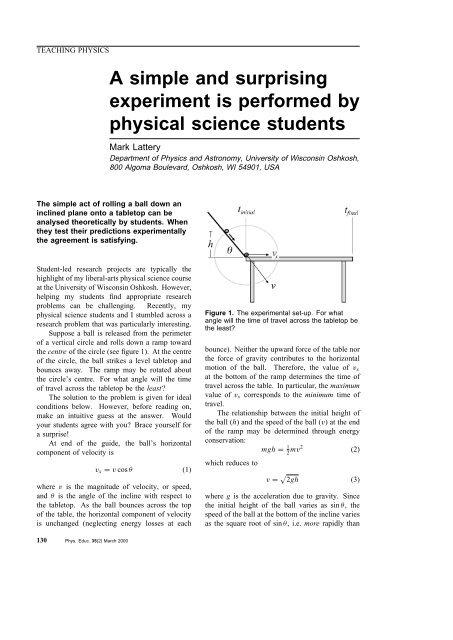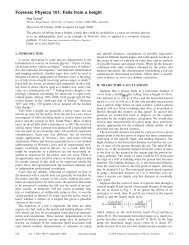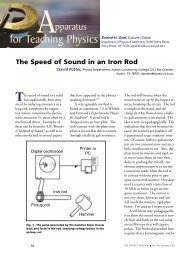A simple and surprising experiment is performed by ... - Senior Physics
A simple and surprising experiment is performed by ... - Senior Physics
A simple and surprising experiment is performed by ... - Senior Physics
Create successful ePaper yourself
Turn your PDF publications into a flip-book with our unique Google optimized e-Paper software.
TEACHING PHYSICS<br />
A <strong>simple</strong> <strong>and</strong> <strong>surpr<strong>is</strong>ing</strong><br />
<strong>experiment</strong> <strong>is</strong> <strong>performed</strong> <strong>by</strong><br />
physical science students<br />
Mark Lattery<br />
Department of <strong>Physics</strong> <strong>and</strong> Astronomy, University of W<strong>is</strong>consin Oshkosh,<br />
800 Algoma Boulevard, Oshkosh, WI 54901, USA<br />
The <strong>simple</strong> act of rolling a ball down an<br />
inclined plane onto a tabletop can be<br />
analysed theoretically <strong>by</strong> students. When<br />
they test their predictions <strong>experiment</strong>ally<br />
the agreement <strong>is</strong> sat<strong>is</strong>fying.<br />
Student-led research projects are typically the<br />
highlight of my liberal-arts physical science course<br />
at the University of W<strong>is</strong>consin Oshkosh. However,<br />
helping my students find appropriate research<br />
problems can be challenging. Recently, my<br />
physical science students <strong>and</strong> I stumbled across a<br />
research problem that was particularly interesting.<br />
Suppose a ball <strong>is</strong> released from the perimeter<br />
of a vertical circle <strong>and</strong> rolls down a ramp toward<br />
the centre of the circle (see figure 1). At the centre<br />
of the circle, the ball strikes a level tabletop <strong>and</strong><br />
bounces away. The ramp may be rotated about<br />
the circle’s centre. For what angle will the time<br />
of travel across the tabletop be the least?<br />
The solution to the problem <strong>is</strong> given for ideal<br />
conditions below. However, before reading on,<br />
make an intuitive guess at the answer. Would<br />
your students agree with you? Brace yourself for<br />
a surpr<strong>is</strong>e!<br />
At end of the guide, the ball’s horizontal<br />
component of velocity <strong>is</strong><br />
v x = v cos θ (1)<br />
where v <strong>is</strong> the magnitude of velocity, or speed,<br />
<strong>and</strong> θ <strong>is</strong> the angle of the incline with respect to<br />
the tabletop. As the ball bounces across the top<br />
of the table, the horizontal component of velocity<br />
<strong>is</strong> unchanged (neglecting energy losses at each<br />
Figure 1. The <strong>experiment</strong>al set-up. For what<br />
angle will the time of travel across the tabletop be<br />
the least?<br />
bounce). Neither the upward force of the table nor<br />
the force of gravity contributes to the horizontal<br />
motion of the ball. Therefore, the value of v x<br />
at the bottom of the ramp determines the time of<br />
travel across the table. In particular, the maximum<br />
value of v x corresponds to the minimum time of<br />
travel.<br />
The relationship between the initial height of<br />
the ball (h) <strong>and</strong> the speed of the ball (v) at the end<br />
of the ramp may be determined through energy<br />
conservation:<br />
mgh = 1 2 mv2 (2)<br />
which reduces to<br />
v = √ 2gh (3)<br />
where g <strong>is</strong> the acceleration due to gravity. Since<br />
the initial height of the ball varies as sin θ, the<br />
speed of the ball at the bottom of the incline varies<br />
as the square root of sin θ, i.e. more rapidly than<br />
130 Phys. Educ. 35(2) March 2000
TEACHING PHYSICS<br />
sin θ! As a result, the horizontal component of<br />
velocity varies as<br />
(√ )<br />
v x ∝ sin θ cos θ. (4)<br />
The quantity v x <strong>is</strong> not symmetric about 45 ◦ as you<br />
might expect! To determine the maximum value<br />
of v x , we set the first derivative of v x with respect<br />
to θ to zero, <strong>and</strong> solve for θ. Th<strong>is</strong> relation reduces<br />
to<br />
sin θ = √ 1/3. (5)<br />
Hence, the maximum value of v x , <strong>and</strong> therefore<br />
the minimum time of travel, occurs at θ ≈ 35.3 ◦ !<br />
But will a real <strong>experiment</strong> show th<strong>is</strong>?<br />
Initially, my students predicted an angle of<br />
least time of about 90 ◦ , reasoning that the speed<br />
of the ball at the end of the guide will be greatest<br />
at th<strong>is</strong> angle. However, students quickly realized<br />
their error. As one student put it, ‘At 90 ◦ , the ball<br />
just goes up <strong>and</strong> down <strong>and</strong> doesn’t get anywhere!’<br />
After more extensive d<strong>is</strong>cussion, the group settled<br />
on a prediction of 45 ◦ , which <strong>is</strong> also incorrect, but<br />
closer to correct answer.<br />
To test their prediction, students rolled a golf<br />
ball down a 2.0 m aluminium track (the ones used<br />
for rolling carts) <strong>and</strong> across a hard tile floor. The<br />
track was mounted on adjustable support beams<br />
to make pivoting the track about a point near the<br />
floor easy. Angles between the track <strong>and</strong> floor<br />
were determined using a protractor.<br />
Students measured time with a digital stopwatch.<br />
One student stood near the bottom of the<br />
guide <strong>and</strong> clapped at the instant the ball reached<br />
the floor. The student operating the stopwatch<br />
started timing at the clap <strong>and</strong> stopped timing when<br />
the ball crossed a pre-defined plane on the floor<br />
several metres away.<br />
Students took measurements at each of 18<br />
angles between 10 ◦ <strong>and</strong> 55 ◦ . Their results are<br />
shown in figure 2. The error bars indicate the<br />
range of values obtained over ten measurements.<br />
The theoretical fit (<strong>performed</strong> <strong>by</strong> the instructor)<br />
takes into account student reaction time. Good<br />
Figure 2. Compar<strong>is</strong>on of theory <strong>and</strong> data. The<br />
error bars indicate the range of results over ten<br />
trials. The angle for the minimum time of travel <strong>is</strong><br />
approximately 35 ◦ .<br />
agreement <strong>is</strong> observed between data <strong>and</strong> theory.<br />
In particular, the minimum time of travel occurs<br />
at θ ≈ 35 ◦ (not 45 ◦ !)<br />
Lacking a deep mathematical background,<br />
students were asked to obtain the correct<br />
theoretical result from Interactive <strong>Physics</strong>† using<br />
the actual physical parameters of their <strong>experiment</strong>.<br />
We found that the dynamic velocity vectors of<br />
the simulation are particularly educational. To<br />
the great sat<strong>is</strong>faction of the students, the model<br />
calculation agreed with their <strong>experiment</strong>al results.<br />
Acknowledgments<br />
We gratefully acknowledge the suggestions <strong>and</strong><br />
comments of Dr Pr<strong>is</strong>cilla Laws (Dickinson<br />
College) <strong>and</strong> Dr S<strong>and</strong>ra Doty (Kenyon College).<br />
We also thank Dr S<strong>and</strong>ra Gade (University of<br />
W<strong>is</strong>consin Oshkosh) for her role as a co-instructor<br />
of the physical science course.<br />
Received 9 November 1999<br />
PII: S0031-9120(00)09422-3<br />
† Interactive <strong>Physics</strong> TM <strong>is</strong> a physics modelling <strong>and</strong> simulation<br />
software program developed <strong>by</strong> Knowledge Revolution (San<br />
Mateo, CA).<br />
Phys. Educ. 35(2) March 2000 131






